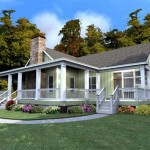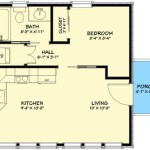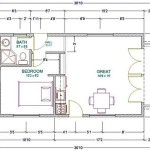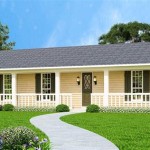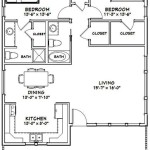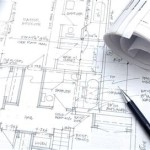Lake Home Plans for Narrow Lots: Maximizing Space and Views
Designing a lake home involves a unique set of considerations, particularly when the available lot is narrow. The challenge lies in creating a functional and aesthetically pleasing residence that maximizes the views, incorporates outdoor living spaces, and accommodates the needs of the occupants without feeling cramped or confined. This article explores the specific design elements and strategies employed in lake home plans tailored for narrow lots, focusing on efficient space utilization, architectural styles that lend themselves to vertical construction, and innovative approaches to capturing the essence of lakeside living within spatial constraints.
Understanding the Constraints of Narrow Lakefront Lots
Narrow lots present limitations that directly impact the design process. The width of the lot dictates the floor plan's footprint, often leading to a tall, narrow structure. This vertical orientation requires careful planning to ensure adequate natural light reaches all levels and that internal circulation is efficient. Setback requirements from property lines and the waterfront further restrict the buildable area, necessitating resourceful use of every square foot. The shoreline itself may also have regulations governing construction, affecting the placement of docks, decks, and other outdoor features. Understanding these constraints is the first step in developing a successful lake home plan for a narrow lot.
One common constraint is the limited space for parking and vehicular access. Narrow lots often lack the width to accommodate a traditional side-entry garage. Designers must explore alternative solutions, such as detached garages, carports, or rear-entry garages accessed via a narrow driveway. This constraint can also influence the placement of the main entrance, potentially requiring a side or rear entry to optimize the front facade for living spaces and lake views.
Another challenge is maintaining privacy from neighboring properties. In closely spaced lake communities, narrow lots can result in homes being in close proximity to each other. Designers must consider the placement of windows, decks, and outdoor spaces to minimize overlooking and maximize the privacy of the occupants. This may involve incorporating strategically placed landscaping, privacy screens, or architectural elements that create visual separation.
Furthermore, the topography of the lot can add complexity to the design. Many lakefront lots slope towards the water, which can create challenges for foundation design and accessibility. However, these sloping sites can also be leveraged to create walkout basements or multiple levels, providing additional living space without expanding the footprint of the home. Careful site assessment and grading are crucial in maximizing the usable space and minimizing the environmental impact of construction.
Architectural Styles Suitable for Narrow Lakefront Properties
Certain architectural styles are inherently better suited for narrow lot lake homes due to their emphasis on verticality and efficient space utilization. These styles can be adapted and modified to meet the specific requirements of the site and the preferences of the homeowner.
The Craftsman style, with its emphasis on vertical lines, gabled roofs, and prominent porches, is a popular choice for lake homes on narrow lots. The vertical orientation of the style allows for the creation of multiple levels, maximizing the living space without expanding the footprint. The use of natural materials, such as wood siding and stone accents, blends well with the lakeside environment.
The Modern Farmhouse style is another viable option, combining the clean lines and minimalist aesthetic of modern architecture with the rustic charm of traditional farmhouses. This style often features tall, narrow windows that allow for ample natural light and maximize views of the lake. The use of board-and-batten siding and metal roofing adds a touch of rural character.
Contemporary designs, characterized by clean lines, large windows, and open floor plans, also lend themselves well to narrow lots. These designs often incorporate multiple levels connected by open staircases, creating a sense of spaciousness and maximizing the flow of natural light. Contemporary homes can be designed to seamlessly integrate indoor and outdoor living spaces, with decks and balconies that extend the living area towards the lake.
In addition to the overall style, specific architectural elements can enhance the appeal and functionality of a narrow lake home. Bay windows can project outwards from the main facade, creating a focal point and expanding the interior space while capturing panoramic views. Dormers can add headroom and natural light to upper levels, making them more livable. Covered porches and balconies provide outdoor living spaces that are protected from the elements, allowing occupants to enjoy the lakeside setting regardless of the weather.
Key Design Considerations for Maximizing Space and Views
Successfully designing a lake home for a narrow lot requires careful consideration of several key design principles. These principles focus on optimizing space utilization, maximizing natural light and views, and creating a functional and comfortable living environment.
The first principle is to prioritize verticality. Building upwards, rather than outwards, is essential for maximizing the living space on a narrow lot. This involves incorporating multiple levels, each with a specific purpose. The ground level may contain a garage, entry foyer, and recreational space, while the main living area is typically located on the second level to take advantage of the best views. Bedrooms are often situated on the upper levels, providing privacy and separation from the main living areas.
Open floor plans are crucial for creating a sense of spaciousness in a narrow home. Eliminating unnecessary walls and partitions allows for a better flow of natural light and creates a more unified living space. The kitchen, dining area, and living room can be combined into a single, open area that feels larger and more inviting. Strategic placement of furniture and architectural elements can define different zones within the open space without creating visual barriers.
Maximizing natural light and views is paramount in a lake home. Large windows, strategically placed to capture the best vistas, are essential. Consider incorporating floor-to-ceiling windows, skylights, and clerestory windows to bring natural light into all areas of the home. Window placement should also consider the orientation of the home to minimize glare and maximize energy efficiency. Decks, balconies, and patios provide outdoor living spaces that extend the living area towards the lake, allowing occupants to enjoy the scenery and the fresh air.
Efficient use of storage space is also critical in a narrow home. Built-in cabinets, shelves, and drawers can provide ample storage without taking up valuable floor space. Consider incorporating storage space under stairs, in hallways, and in other unused areas. Multi-functional furniture, such as sofa beds and storage ottomans, can also help to maximize space utilization.
Finally, consider the accessibility of the home. If the lot slopes towards the lake, a walkout basement can provide additional living space and easy access to the waterfront. Incorporating ramps or elevators can make the home accessible to people with mobility issues. Universal design principles, such as wider doorways and grab bars in bathrooms, can enhance the usability of the home for people of all ages and abilities.
Innovative Features for Small Lake Home Design
Beyond the fundamental design considerations, several innovative features can further enhance the functionality and appeal of a lake home on a narrow lot. These features focus on maximizing space, creating unique living experiences, and integrating technology to improve the overall living environment.
One innovative feature is the use of multi-functional spaces. A guest bedroom can be designed to function as a home office or a media room when not occupied by guests. A dining area can be transformed into a game room or a reading nook. Designing spaces with multiple uses allows for greater flexibility and maximizes the utilization of the available square footage.
Another innovation is the incorporation of retractable or folding walls. These walls can be used to divide or combine spaces as needed, creating a flexible and adaptable living environment. For example, a retractable wall can be used to separate the dining area from the living room for formal occasions or to create a more intimate space for smaller gatherings. Folding walls can also be used to extend the indoor living space to the outdoors, creating a seamless transition between the interior and exterior.
Smart home technology can also play a significant role in enhancing the functionality and convenience of a narrow lake home. Smart lighting systems can be programmed to automatically adjust the lighting levels based on the time of day or the occupancy of the room. Smart thermostats can optimize energy efficiency and maintain a comfortable temperature throughout the home. Security systems can provide remote monitoring and control, ensuring the safety and security of the property.
Outdoor living spaces can be enhanced with innovative features such as outdoor kitchens, fireplaces, and hot tubs. These features create a luxurious and inviting outdoor environment that can be enjoyed year-round. Outdoor lighting can extend the usability of the outdoor spaces into the evening hours, creating a magical ambiance. Fire pits provide a warm and inviting gathering place for friends and family.
Finally, consider incorporating sustainable design features into the lake home. Solar panels can generate electricity, reducing the reliance on fossil fuels. Rainwater harvesting systems can collect rainwater for irrigation and other non-potable uses. Energy-efficient windows and insulation can minimize energy consumption and reduce utility bills. Sustainable building materials, such as reclaimed wood and recycled content products, can reduce the environmental impact of the construction project.
Designing a lake home for a narrow lot presents unique challenges, but also offers exciting opportunities for creativity and innovation. By carefully considering the constraints of the site, selecting an appropriate architectural style, and incorporating key design principles, it is possible to create a functional, aesthetically pleasing, and sustainable lake home that maximizes space, captures stunning views, and provides a comfortable and enjoyable living environment.

Luxe Lake House Plans From Visbeen Architects Houseplans Blog Com

Narrow Lot Lake House An Ideabook By Bcfry

Small Cosy Homes Narrow Lot House Plans Mediterranean Style Lake

Narrow Lot House Plans And Designs Sater Design Collection

Lake House On Long Narrow Lot Google Search Designs Exterior Mountain

Aaron S Beach House Coastal Plans From Home

Simple Narrow Lot House Plans Houseplans Blog Com

House Plan Of The Week Narrow Lot Beach Home Designers

Narrow Lot House Plan For Lake Lots Max Fulbright Designs

House Plans For Narrow Lots On Waterfront Lake Small Houses Lot

